Since Apollo, Parkes has often participated in tracking Deep
Space missions.
During the Voyager 2 encounters with Uranus and Nepture, Parkes and the antennas at Tidbinbilla (CDSCC)
were arrayed to substantially increase the rates at which science data could
be received from the spacecraft. This arrangement was known as the Parkes–Canberra Telemetry Array (PCTA).
[A page on the PCTA is planned.]
 |
This plot of expected data rates from Voyager 2 shows the impact of arraying Tidbinbilla (CDSCC) and Parkes.
The leftmost curve shows data rates expected at Goldstone.
The rightmost curve represents Madrid. The lower elevation of Uranus at Madrid would be a major factor in lower data rates.
The central two curves represent the data rate at Tidbinbilla with and without the array with Parkes.
It was because of this advantage that the Voyager 2 encounter with Uranus was timed to coincide with coverage by the PCTA.
Plot courtesy of Doug Mudgway’s Uplink – Downlink.
The above plot is also in the Tidbinbilla / Voyager 2 section. |
When Mike Dinn re-joined the team at Tidbinbilla in 1983, StaDir Tom Reid tasked him with overseeing the implementation of the array.
Voyager 2 was launched on August 20, 1977.
After encountering Jupiter in July 1979, and Saturn in August 1981, Voyager 2 was directed to Uranus and Neptune, and ultimately, out of the Solar System.
Uranus encounter, January 1986.
On January 25 (Australian time) 1986, the spacecraft passed just 81,500 kilometres above the cloudtops of Uranus.
In 1991, former Parkes Director Jon Ables remembered,
“We were supporting two space probes at the same time: the ESA Giotto mission to comet Halley and NASA's Voyager mission to Uranus, with only a few weeks between the two encounters. ESA had first ‘dibs’ on the space in the control room because they signed a contract with us first.
We didn’t think there’d be any problem, since we had a lot of empty space in that control room after we’d cleaned it all up. So, ESA chalked off how much floor space they wanted – which was all of it – and proceeded to move in. They left NASA two racks and a desk! ESA then moved in several hundred boxes of equipment.
So NASA moved into a box, known as Dinn’s Diner, out on the apron. This is where NASA installed their equipment for support of Voyager; it’s still there. We connected this to the main floor of the control room by a set of cables, which we fondly called the rose trellis, climbing up the outside of the telescope tower. Both space agencies used the same expensive receiver, basically a NASA design but paid for by ESA.”
– Quoted from page 138, “Parkes: Thirty Years of Radio Astronomy”, edited by D.E. Goddard and D.K. Milne, CSIRO, 1994. ISBN 0 643 05547 9.
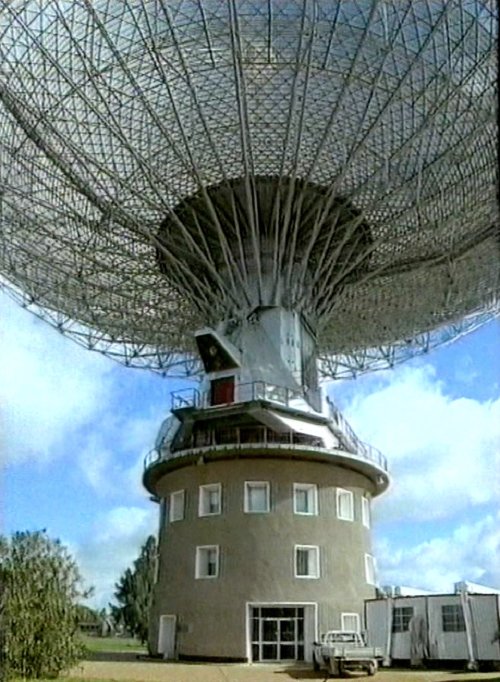 |
|
For the Voyager 2 Uranus encounter, a large amount of equipment from Tidbinbilla was installed in the portable building at right, parked next to the telescope. Neil Sandford played a key role in the design and installation. Mike Dinn was tasked with running the operation, and hence the building became known as “Dinn’s Diner”.
Image assembled from a CSIRO video. |
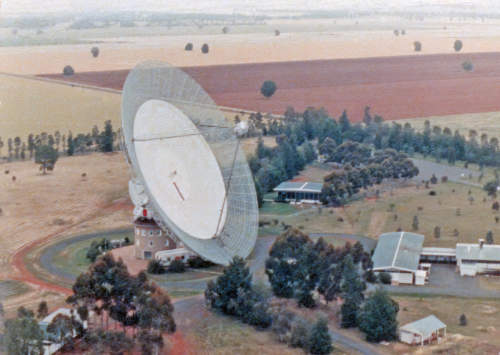 |
Dinn’s Diner is visible in this aerial photo which was on display in the Tidbinbilla Visitors Centre in 1989. Scan by Colin Mackellar. |
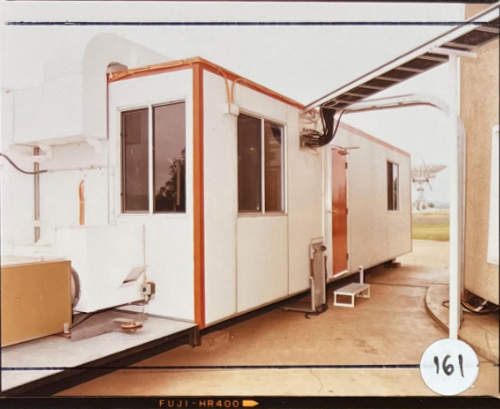 |
Dinn’s Diner is next to the Parkes Radio Telescope tower.
Note the cables coming in from the first floor on “the rose trellis”.
4x5 inch contact print from the Tidbinbilla archives. Scan by Colin Mackellar. |
 |
Dinn’s Diner viewed from the other end. The main entrance to the tower is out of frame to the left.
4x5 inch contact print from the Tidbinbilla archives. Scan by Colin Mackellar. |
This series of photos was taken by a visitor from JPL (probably Frank Donivan, Radio Science investigator).
They were preserved by Mike Dinn and scanned by Colin Mackellar.
Any help with names would be appreciated.
(Higher resolution versions available on request.)
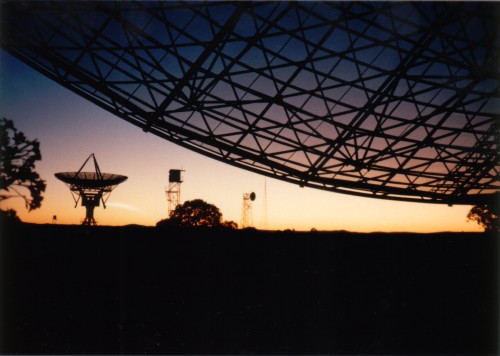 |
18. Sunrise at Parkes. |
 |
And here’s an autographed copy – preserved by Hamish Lindsay. Scan by Colin Mackellar. |
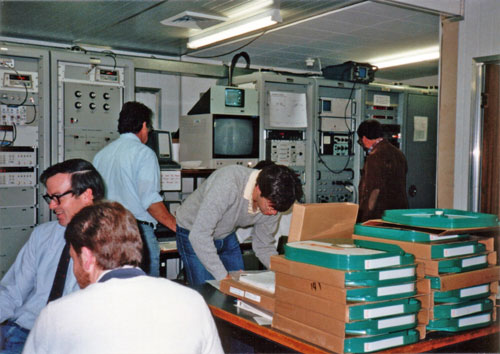 |
1. Voyager II Uranus encounter at Parkes.
Note the telemetry tapes on the table. |
 |
2. Paul Mullen is seated at left. Peter Churchill (later CDSCC StaDir) is standing with back to the camera. |
 |
3. Countdown to encounter. |
 |
4. L-R: ?, Dwight Holmes, Mike Dinn, Peter Churchill, Paul Mullen. |
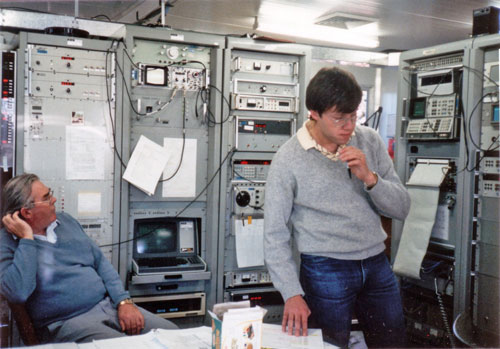 |
5. |
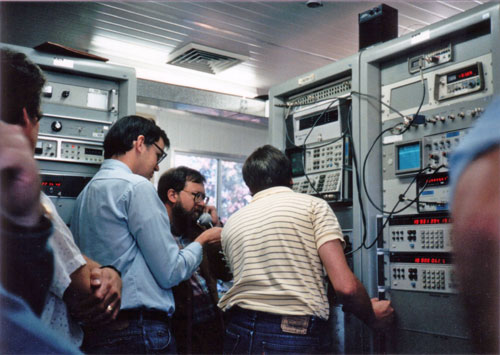 |
6. |
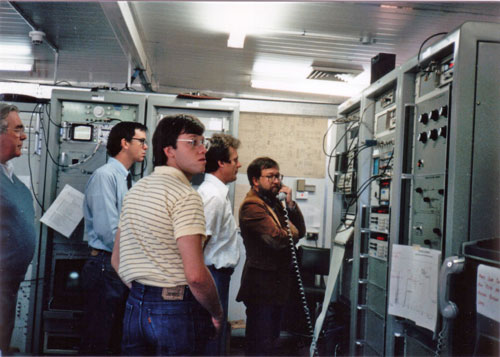 |
7. |
 |
8. |
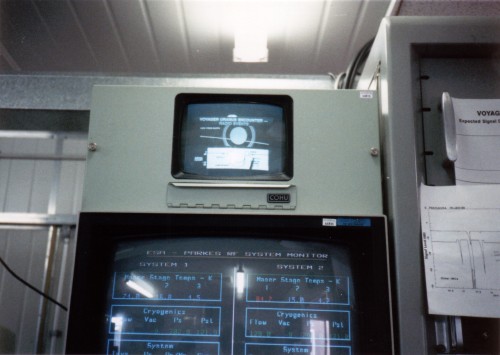 |
11. Display showing radio events for the encounter. |
 |
12. Mike Dinn at left, Len Litherland in centre. |
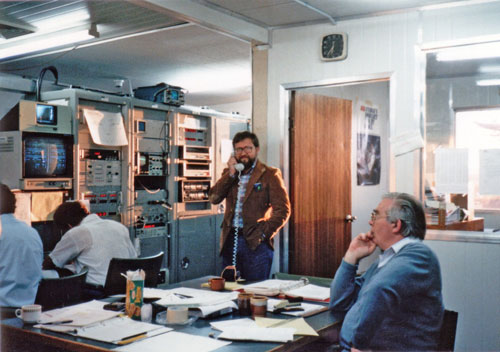 |
14. Dwight Holmes, JPL, on the phone. |
 |
16. Peter Churchill at the keyboard. |
Peter Churchill adds (2023):
“I spent the Voyager II Uranus encounter at the Parkes telescope where we had a
demountable building set up beside the pedestal.
I remember we had a spare chart recorder set up attached to the equipment so we could see the incoming signal strength. We were advised that a
particular signature should be identifiable if Uranus had an ionosphere
which was an unknown at the time.
Sure enough, the signature showed up, so
we joked that there were several of us at Parkes and probably a dozen at
CDSCC that were the first people to know that Uranus has an ionosphere,
because it took about 6/10ths of a second for the data to arrive at JPL.”
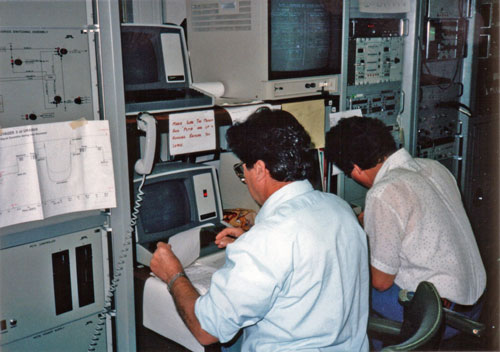 |
20. Paul Mullen and Peter Churchill. |
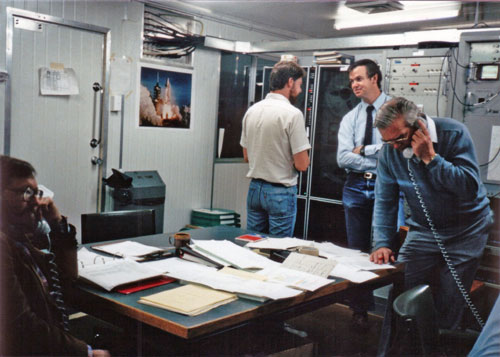 |
21. |
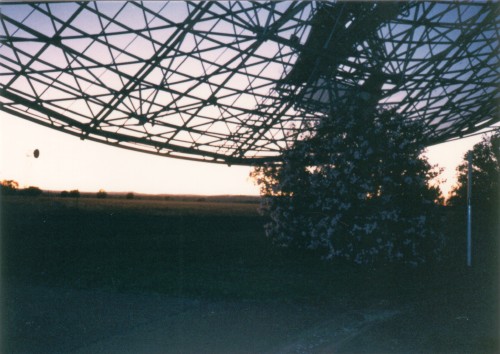 |
15. Sunrise. |
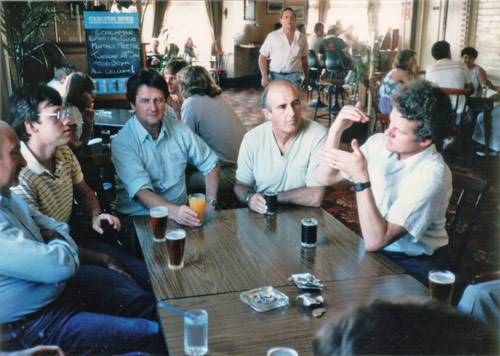 |
10. Relaxing after a track.
Len Litherland, ?, Paul Mullen, John Sloan, Peter Churchill. |
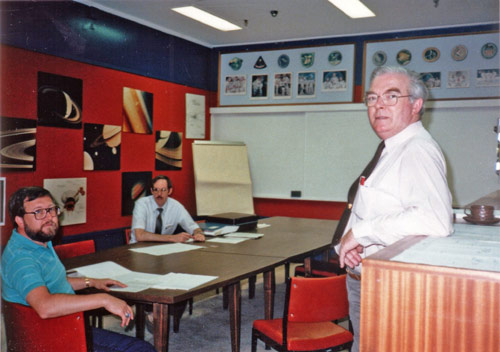 |
9. At Tidbinbilla.
Dwight Holmes, Frank Donivan JPL, Mike Dinn. |
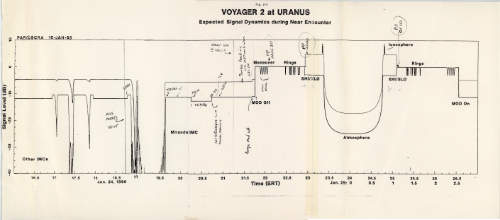 |
Mike Dinn preserved this plot of expected signal dynamics around the time of Uranus Near Encounter. |
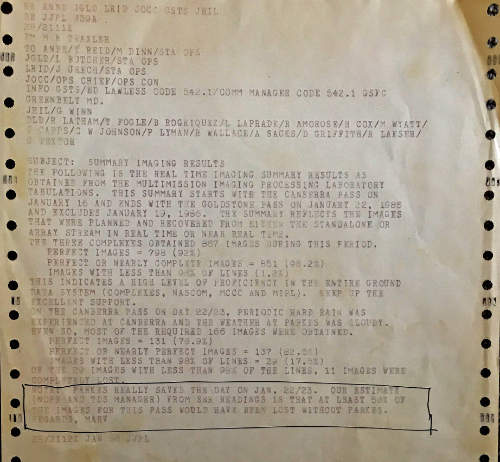 |
This message from the DSN’s Marvin Traxler to the stations praises their excellent support in receiving images from Voyager 2 at Uranus in the period January 16–22 1986.
It also confirms the wisdom of using the Parkes – Canberra Telemetry Array. On the 22/23 January pass, “hard rain” at Tidbinbilla attenuated the signal, so having Parkes “really saved the day”. |
Neptune encounter, August 1989.
On August 25 1989, Voyager 2 encountered Neptune, passing 4,950 kilometres above the gas giant’s north pole.
Point of closest approach (PCA) was at 13:57AEST.
These photos show members of the Tidbinbilla team at Parkes for the encounter. Photos courtesy of John Sarkissian and CSIRO.
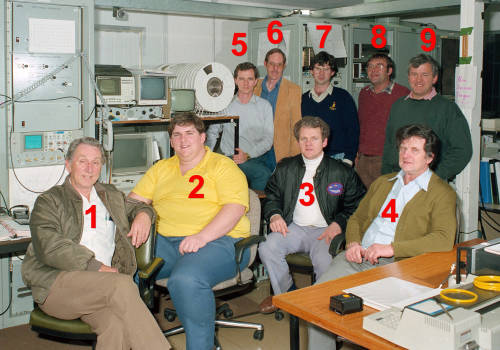 |
1. Neil McVicar, CDSCC
2. Mr Orlandi, a Parkes local who worked as a casual operator
3. Peter Churchill, CDSCC
4. Paul Mullen, CDSCC
5. Bob Jenkins, CDSCC RF engineer
6. Frank Donivan, JPL
7. John McCaffery, CDSCC
8. Bob Beard, CDSCC
9. Richard Jacobsen, CDSCC Deputy Director at the time.
With thanks to Peter Churchill and Mike Dinn for the names. |
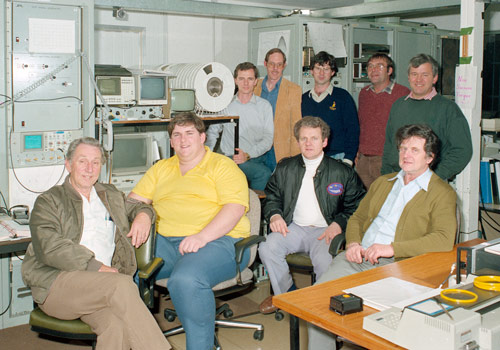 |
14. The Tidbinbilla (CDSCC) team at Parkes. |
 |
16. The Tidbinbilla (CDSCC) team at Parkes. |
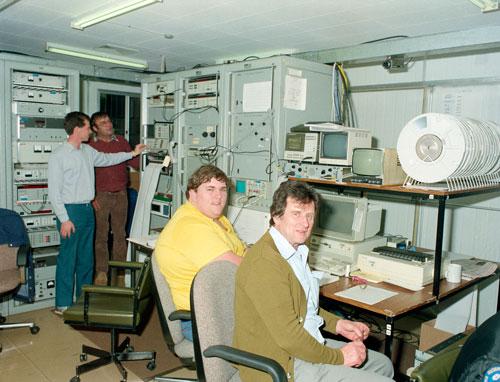 |
17. The Tidbinbilla (CDSCC) team at Parkes. |






























